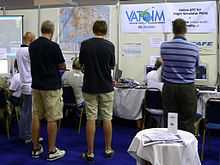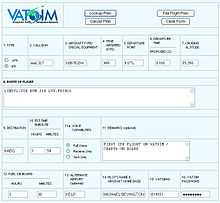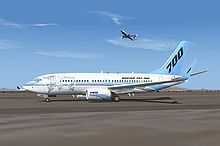Virtual Air Traffic Simulation Network
 | |
| Abbreviation | VATSIM |
|---|---|
| Motto | As real as it gets[1] |
| Formation | July 2001 |
| Type | Unincorporated |
| Purpose | Provide an online air traffic control and flying community for aviation enthusiasts |
Region served | Worldwide |
Membership | Private persons |
President | Steven Cullen |
Main organ | Board of Governors |
Volunteers | 130,000+[2] |
| Website | http://www.vatsim.net |
VATSIM, or Virtual Air Traffic Simulation Network, is a non-profit organization operating a dedicated, worldwide, Internet-based flight-simulation network.[3] Users can connect to the network to either fly online as a pilot using flight simulation software, or direct traffic as an air traffic controller (ATC) and participate in what has been described as a close approximation of real-life aviation procedures.[4][5][6][7] The organization has achieved notability for its very high level of participation and realism, that has seen it in use as part of Federal Aviation Administration funded research projects. This notability resulted in the organization being featured on the front page of The Wall Street Journal in 2006.[4] It is considered the largest online flight simulation network in the world with over 209,000 registered members as of September 3, 2009,[8] with hundreds of participants online at any one time.[9][10]


Overview
VATSIM is one of the two main providers[11] of flight-simulation networks that allows users to either fly online as a pilot, or direct traffic as an air traffic controller (ATC).[4] Communications between pilots and controllers are carried out using integrated voice-over-IP or in-game text messages. Users require custom software to use the network. Through VATSIM, ordinary people have come together as a network of pilots interacting with air traffic controllers to produce a vast, organic simulation of actual air traffic.[5][6]
The goal is to keep the simulation as close as possible to real-life aviation procedures, including realistic procedural standards and radio phraseology. This has made VATSIM a training aid to student pilots who lack experience at communication with air traffic control, as well as private and commercial pilots looking to enhance their skills, especially in radio communications.[12] In achieving this the network has been highlighted as bringing more immersion to what was once a solitary exercise,[9] events in the game are no longer just programmed into the software but are introduced by the combination of human effort and error.[13] Networks such as VATSIM have been described as offering very strict experiences, and may achieve very high levels of standards for training and currency even for those already involved in real world flying.[14] The network has been highlighted as being a key component in the development of the Flight Simulation as commodity software.[15]
Much like its real-world counterparts, VATSIM is divided into separate geographic areas each with slightly different operating procedures to handle the various local differences. VATSIM is divided into six regions which are further subdivided into country-specific divisions. The divisions themselves are divided into Flight Information Regions (FIRs), Virtual Area Control Centers (vACCs) and Air Route Traffic Control Centers (ARTCCs).[16]
The six regions are:
History
The VATSIM organization was founded as a result of the dissolution of the Simulated Air Traffic Controllers Organization (SATCO) in July 2001.
SquawkBox and ProController
In the mid 1990s, the evolution of the Internet and modern flight simulators allowed users to fly together using multiplayer functions of the simulators. In 1997, the first version of SquawkBox was created by Jason Grooms with later versions developed by Joe Jurecka as an add-on for Microsoft's Flight Simulator 95, enhancing the built-in multiplayer features to allow large numbers of players to connect to the game. ProController, a radar simulation program also developed by Jason Grooms, was created in the same year and allowed pilots and controllers to be connected. A third component, the FSD Server, was created by Marty Bochane which provided the signaling infrastructure and logic required to tie ProController and Squawkbox together in a logical fashion. The creation of these three programs allowed large-scale multiplayer to occur, whereas previously only one controller could control a single player. The system also allowed, for the first time, a user to fly around in real-world weather conditions which changed as they flew.
Formation of VATSIM
Former staff members from SATCO commenced the creation of a new organization, almost immediately spearheaded by former Deputy Director Harvey Stein. The organization was formally announced as VATSIM on July 12, 2001, with the grand opening to occur later in that month.[2] Stein was then elected as the President of the Board. The VATSIM Board of Governors had drawn up terms of agreement with Randy Whistler from SATCO that saw VATSIM become the official successor of SATCO.
Reception
The network has attracted significant attention in the media, including a Wall Street Journal article[4] and coverage in newspapers,[2] radio,[10] and magazines[17] around the world. Much of this coverage is in mainstream media, not limited computer gaming or information technology media outlets. Coverage has been overwhelmingly positive, although often emphasizing the peculiar nature of those enjoying such a complex hobby that to many closely approximates work and can cost thousands of dollars.[10][18]
Commentators have described the network as giving flight simulators an interest and depth that they would not otherwise have.[19] The network's greatest asset as been described as the positive attitude and friendliness of it members.[17] It has also been praised for its realism and the quality of its software.[20] It is considered the largest online flight simulation network in the world.[8] Air & Space magazine described the network as being an active, extremely realistic approximation of real flight conditions, praising the quality of both pilots and controllers in promoting a realistic experience.[14] The experience has been described as very strict, going further than some participants might like or enjoy.[6]
Software


VATSIM is supported by what has been described as remarkably complex and robust software to allow the operation of the network.[20] This software has allowed the online flying experience to become increasingly realistic with software that closely resembles the screens used in the real world for managing aircraft.[21] Users need custom plugins (such as SquawkBox, FSInn, vPilot or XSquawkBox) for flight simulators (such as Microsoft Flight Simulator, Prepar3D or X-Plane) to connect as pilots, or radar simulation applications Advanced Simulated Radar Client (ASRC), Virtual Radar Client (VRC) or EuroScope to connect as air traffic controllers. VATSIM-specific applications are available for free and provided by the network itself.
Network service is provided by proprietary servers located throughout the world. All servers are interconnected so that users can see each other on the network, no matter which particular server they connect to.
There are also additional 3rd party tools available that are not essential for the usage of the network, but can provide useful information such as aggregated statistics for airports, route information, and flight history.
Membership and training
The network has 197,512 registered members,[8] with more than 10,000 of these classed as currently active, in August 2009.[22][23]
Users must join the organization as members before they can connect to the network, but membership is free. Members must be at least 13 years old. There are no usage fees for connection to the VATSIM network. It is common for younger members interested in getting into real world flying to use the network to develop their skills, particularly the often daunting task of communicating with other pilots and Air Traffic Control. The network provides the opportunity for those new to aviation to develop their skills through a series of training programmes modeled on what is required in the real world.[24]
The VATSIM network does not require virtual pilots to take any training before flying, however virtual air traffic controllers are required to undertake mandatory training before opening a controlling position.[25] In 2005 the Israeli airline El Al required more than 700 of its new pilots to go through a personal computer simulation that was hosted by the members of VATSIM to provide realistic training for their pilots.[4][26]
VATSIM is governed by a self-appointing board of governors and an executive committee. The current president of VATSIM is Steven Cullen. Administration and day-to-day operations are supported by volunteers, donations, and sponsorship. Network supervisors are also appointed to handle day-to-day issues that may arise and offer assistance. Use of the network is free.
Events


The VATSIM network is open 24 hours a day and network downtime is extremely rare; pilots and controllers are free to connect and fly or control anywhere in the world at any time (subject to qualification restrictions in the case of controllers). However, the network and different ATC centers sponsor regular events to encourage pilots and ATC to congregate at various locations in the world, usually several times a week. At the most popular of these events, traffic levels may be comparable to those of the same locations in real life.[14]
VATSIM and MITRE
The MITRE Corporation is a public-interest not-for-profit organization. It is a federally funded research and development center for the Federal Aviation Administration (FAA), and is dedicated to improving aviation system safety, security, and performance.[27] To date, a division of the MITRE Corporation called the Center for Advanced Aviation System Development (CAASD) and VATSIM have conducted three events to assist with the achievement of research aims for CAASD.[23]
On January 5, 2008, after a long period of planning and negotiation, VATSIM held a major simulation event as part of a cooperative effort with CAASD to assess the viability of VATSIM as a platform for certain categories of real-world air traffic simulation. Some 500 VATSIM pilots and dozens of VATSIM air traffic controllers participated in the event. Pilots flew routes preplanned by MITRE to simulate real-world traffic levels at Chicago's O'Hare and Midway airports over a period of several hours, with landings and take-offs at each airport being spaced as closely as every two minutes. Some objectives of this first cooperative event included load testing of the VATSIM network infrastructure and assessment of pilot and ATC skills within the membership.[28]
This was followed by two additional events in February 2008 at the McCarran International Airport in Las Vegas. The first event tested pre-departure clearance procedures, while the second explored arrival procedures at Atlanta Hartsfield International Airport, conformance to published Standard Terminal Arrival Routes (STARs), and new Air Traffic Control (ATC) phraseology.[23] In September 2008 another event tested the realism of simulated flight management systems during continuous descent approaches. For each event, participants were required to dedicate more time to the experiments by familiarizing themselves with training materials, phraseology, and pre-testing to ensure they understood the material prior to the event.[23]
Worldflight
Worldflight Australia is a virtual round-the-world flight to raise money for the Australian Royal Flying Doctor Service, for which VATSIM has provided virtual air traffic control over the years it has been running.[29] In 2006, fifteen virtual flying enthusiasts used a full-sized simulator of a Boeing 747-400 in Australia to conduct a 130-hour round-the-world trip, for which Qantas Airways provided the food and VATSIM provided air traffic control.[18] The event for 2008 raised over $30,000 USD, with over 200 pilots participating in the event in addition to the crews of the seven full cockpit simulators that were the focus for the fund raising event.[30] The home built simulator cockpits were extensive, some costing between $10,000[10] and $300,000[18] AUD to make and taking years to complete.
See also
- Virtual airline (hobby)
- MITRE Corporation
- Flight Simulator
- Massively multiplayer online game
- Air Traffic Control
- Boston Virtual ATC
- International Virtual Aviation Organisation
References
- ↑ "Who are we". VACC Czech Republic. Retrieved April 19, 2015.
- ↑ 2.0 2.1 2.2 Terdiman, Daniel (December 16, 2006). "Into the wild blue virtual yonder". CNET News.com. Retrieved April 29, 2008.
It formed in 2001 when internal politics in a precursor network, SATCO, caused a rupture that resulted in two rival networks: VatSim ... and IVAO
- ↑ Radcliffe, Doug; Andy Mahood (2003). Microsoft Flight Simulator 2004: A Century of Flight (Official Strategy Guide). John Wiley & Sons. p. 188. ISBN 0-7821-4237-0.
- ↑ 4.0 4.1 4.2 4.3 4.4 Sanders, Peter (May 18, 2006). "In Imaginary Skies, Would-Be Controllers Guide Pretend Pilots". Wall Street Journal. Retrieved April 29, 2008.
- ↑ 5.0 5.1 Castronova, Edward (2005). Synthetic Worlds: The Business and Culture of Online Games. University of Chicago Press. p. 158. ISBN 0-226-09626-2.
- ↑ 6.0 6.1 6.2 Wallace, Lane (October 1, 2006). "Microsoft Unveils Mission-Capable Flight Sim X". Flying. p. 45. Retrieved April 15, 2009.
Systems like VATSIM are apparently very strict experiences, however, with standards for training and currency that can be more intense and involved than some pilots want to undertake.
- ↑ Gauger, Eliza (November 21, 2006). "Air Traffic Control for a Larf". Wired News. Retrieved March 24, 2011.
- ↑ 8.0 8.1 8.2 Van West, Jeff; Kevin Lane-Cummings (2007). Microsoft Flight Simulator X for Pilots. John Wiley and Sons. pp. 672–685. ISBN 0-7645-8822-2.
VATSIM is the largest network, with more than 110,000 registered members
- ↑ 9.0 9.1 Stewart, Laverne (December 5, 2009). "Flight Simulation". The Daily Gleaner. Retrieved March 24, 2011.
- ↑ 10.0 10.1 10.2 10.3 Rheinberger, Joel (November 28, 2008). "Flight simulator takes off in Lauderdale". 936 ABC Hobart. Retrieved March 24, 2011.
- ↑ D’Alessandro, Nic (November 15, 2007). "Transference of PC based simulation to aviation training: issues in learning" (PDF). InSite Solutions (Tas.) Pty Ltd. Retrieved April 29, 2008.
- ↑ Maharg, Paul (2007). Transforming Legal Education. Ashgate Publishing. p. 165. ISBN 0-7546-4970-9.
- ↑ McCracken, Grant (May 16, 2006). "How virtual worlds discovered dynamism". Intersection of Anthropology and Economics. Retrieved July 14, 2008.
- ↑ 14.0 14.1 14.2 Regis, Ed (January 1, 2009). "Welcome to Cyberairspace". Air & Space Magazine. Retrieved March 28, 2011.
- ↑ Takeda, K.; Newman, S.J., Kenny, J. and Zyskowski, M (2008). "Convergence: commodity flight simulation and the future". Aeronautical Journal (California: University of California) 112 (1136). Retrieved May 7, 2009.
- ↑ Galvin, John (March 2003). "Always a Dull Moment". Wired. Retrieved April 14, 2008.
- ↑ 17.0 17.1 "Gaming News". PC Gamer (GP Publications) 15 (4–13). 2008. Retrieved March 28, 2011.
- ↑ 18.0 18.1 18.2 Galvin, Nick (June 6, 2006). "Cockpit capers". Sydney Morning Herald. Retrieved January 14, 2009.
- ↑ Maharg, Paul (2007). Transforming legal education: learning and teaching the law in the early twenty-first century. Ashgate Publishing, Ltd. p. 346. ISBN 0-7546-4970-9.
- ↑ 20.0 20.1 Kimbrough, Steven O.; D. J. Wu (2004). Formal Modelling In Electronic Commerce. Birkhäuser. p. 17. ISBN 3-540-21431-3.
There now exists a vibrant community organized around VATSIM, as well as remarkably complex and robust software supporting these activities.
- ↑ Barter, Pavel (July 13, 2008). "Flights of Fancy". CVG. Retrieved July 14, 2008.
...three air traffic control programs which are amazingly close to the screens used in the real world.
- ↑ Terdiman, Daniel (December 16, 2006). "Into the wild blue virtual yonder". CNET News.com. Retrieved April 29, 2008.
..the network has had just under 130,000 accounts registered, and has more than 10,000 active users...
- ↑ 23.0 23.1 23.2 23.3 "VATSIM: Taking R&D from Virtual to Reality" (Press release). MITRE Corporation. August 20, 2008. Retrieved January 29, 2009.
- ↑ Orr, Josh (May 2, 2006). "Teen earns wings for his first solo flight". Sarasota Herald Tribune. Retrieved July 14, 2008.
- ↑ "The International Online Flying Network: Air Traffic Control". VATSIM. Retrieved July 18, 2013.
- ↑ Margulius, David (May 26, 2006). "Tech jobs take stress to whole new levels". InfoWorld. Retrieved April 29, 2008.
...is so realistic that some commercial airlines are starting to use it to train [their] pilots...
- ↑ "About the MITRE Corporation". MITRE Corporation Website. Retrieved January 29, 2009.
- ↑ "VATSIM – Virtual Air Traffic Simulation Network" (Press release). MITRE Corporation. January 12, 2008. Retrieved April 14, 2008.
- ↑ "Worldflight Australia". Worldflight Australia Website. Retrieved January 14, 2009.
- ↑ "WorldFlight 2008 raises over $30,000" (Press release). VATSIM. January 12, 2009. Retrieved January 14, 2009.
External links
- Official website – Includes links to region- and division-specific web sites.
- vataware – Detailed statistics & live flight tracking for VATSIM traffic.
- Worldflight Group – Worldflight Group official website.